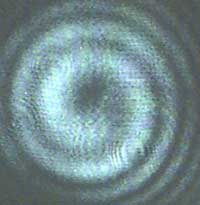The computer behind the screen on which this article appears processes commands a bit at a time, using units of information comprised of either zeros or ones. Scientists can likewise use light to encode information because photons exist in one of two possible spin states. But photons also carry a property known as orbital angular momentum (OAM), which can take on an infinite number of values. A reliable method of measuring orbital angular momentum might therefore lead to a way of packing significantly more data into a beam of light. To that end, findings published in the June 24 issue of Physical Review Letters could help. Scottish researchers report that they have succeeded in both sorting individual photons according to their OAM and encoding two bits of information on a single photon.
 To exploit the angular nature of photons, Jonathan Leach of the University of Glasgow and his colleagues forced a ray of light through a variety of beam splitters and prisms. After dividing a single light beam into two, the team set up prisms that rotated each arm to varying degrees. When the beams were recombined, the researchers could sort the photons based on whether or not the beams remained identical (and showed constructive interference) because the phase shift between two beams is governed by OAM. (The image above shows the interference pattern generated by a light beam with OAM .) By sending sorted beams through additional prisms, the team could discriminate among four different values of OAM. The scientists then lowered the intensity of the beam so that only a single photon entered the equipment at any one time, allowing them to separate individual photons according to OAM.
To exploit the angular nature of photons, Jonathan Leach of the University of Glasgow and his colleagues forced a ray of light through a variety of beam splitters and prisms. After dividing a single light beam into two, the team set up prisms that rotated each arm to varying degrees. When the beams were recombined, the researchers could sort the photons based on whether or not the beams remained identical (and showed constructive interference) because the phase shift between two beams is governed by OAM. (The image above shows the interference pattern generated by a light beam with OAM .) By sending sorted beams through additional prisms, the team could discriminate among four different values of OAM. The scientists then lowered the intensity of the beam so that only a single photon entered the equipment at any one time, allowing them to separate individual photons according to OAM.
The findings represent an encouraging step toward exploiting OAM for quantum information processing, the authors note. Although they were able to discriminate among only four values out of an infinite number of options for OAM, they conclude that the ability to measure a single photon's OAM provides the possibility of a much greater density of information transfer.
Sarah Graham
|